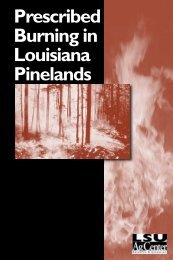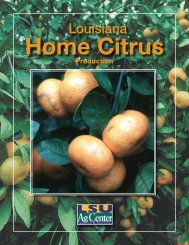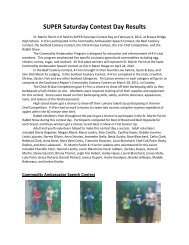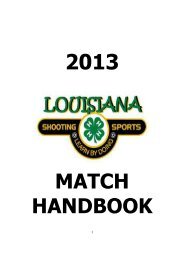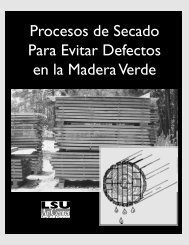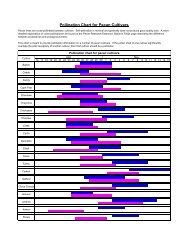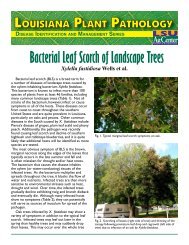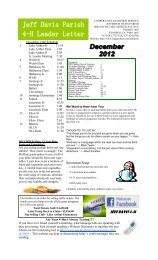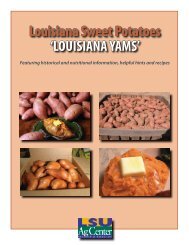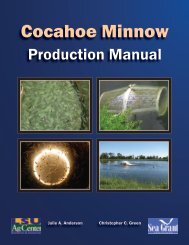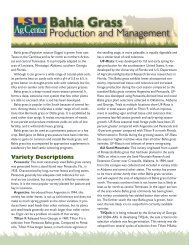SRAC 0471: Fertilization of Fish Ponds
SRAC 0471: Fertilization of Fish Ponds
SRAC 0471: Fertilization of Fish Ponds
You also want an ePaper? Increase the reach of your titles
YUMPU automatically turns print PDFs into web optimized ePapers that Google loves.
When ponds are fertilized, nutrients<br />
stimulate the growth <strong>of</strong><br />
microscopic plants in the water<br />
(phytoplankton). Phytoplankton is<br />
food for other organisms (zooplankton<br />
and larger animals) that<br />
are eaten by fish. Abundant<br />
growth <strong>of</strong> these microscopic<br />
plants gives water a turbid, greenish<br />
color (called a “bloom”) that<br />
can prevent light from reaching<br />
the pond bottom and reduce the<br />
growth <strong>of</strong> rooted aquatic weeds.<br />
<strong>Fish</strong> farmers and recreational farm<br />
pond owners fertilize ponds to<br />
increase fish production and prevent<br />
rooted aquatic weeds from<br />
becoming established. Aquaculture<br />
ponds are fertilized to<br />
increase the available natural food<br />
(phytoplankton and zooplankton)<br />
for fry or larval fish, or for species<br />
that are efficient filter feeders.<br />
Recreational ponds also are fertilized<br />
to increase the available natural<br />
food organisms. A well-managed<br />
fertilized recreational pond<br />
can produce 200 to 400 pounds <strong>of</strong><br />
fish per acre annually. This is<br />
three to four times the fish production<br />
that can be obtained without<br />
fertilization.<br />
Not every pond should be fertilized.<br />
In many cases, increased fish<br />
production is not desirable. If a<br />
pond serves primarily for watering<br />
cattle or for wildlife habitat,<br />
fertilization is unnecessary. Pond<br />
1 Mississippi State University<br />
2 University <strong>of</strong> Arkansas at Pine Bluff<br />
March 1999<br />
<strong>Fertilization</strong> <strong>of</strong> <strong>Fish</strong> <strong>Ponds</strong><br />
Martin W. Brunson 1 , Nathan Stone 2 , and John Hargreaves 1<br />
owners who want clear water<br />
should not fertilize either. Unless<br />
a pond will be fished more heavily,<br />
fertilization to increase fish<br />
production is <strong>of</strong> little value.<br />
<strong>Ponds</strong> are <strong>of</strong>ten fertilized to<br />
increase yields <strong>of</strong> bass and sunfish<br />
(bream). But if the bream population<br />
is too large or is otherwise<br />
out <strong>of</strong> balance with the bass population,<br />
that should be corrected<br />
before a fertilization program is<br />
begun. <strong>Ponds</strong> dominated by<br />
undesirable fish species also<br />
should not be fertilized until those<br />
fish are eradicated. It is usually<br />
not necessary to fertilize catfish<br />
ponds in which the fish are fed<br />
regularly, since uneaten feed is a<br />
supplemental nutrient source.<br />
Raising catfish with feed is an<br />
excellent choice for producing fish<br />
in ponds that have low alkalinity<br />
water (see next section) and where<br />
liming is not an option.<br />
Before fertilizing<br />
Before beginning a fertilization<br />
program, have the alkalinity, total<br />
hardness, and calcium hardness <strong>of</strong><br />
your pond water tested. Your<br />
local Cooperative Extension<br />
Service <strong>of</strong>fice can help with water<br />
testing. Waters that are low in<br />
alkalinity or total hardness (below<br />
20 mg/L) will need liming in<br />
order for fertilizers to be effective.<br />
Most ponds that receive run<strong>of</strong>f<br />
from watersheds with acid soils<br />
will have low alkalinity/low<br />
hardness water. Typical applica-<br />
PR<br />
<strong>SRAC</strong> Publication No. 471<br />
VI<br />
tion rates for agricultural or<br />
dolomitic limestone are 1 to 3<br />
tons/acre. The recommended liming<br />
rate is based on the lime<br />
requirement <strong>of</strong> the pond bottom<br />
soils, as determined by soil testing.<br />
Again, contact your local<br />
Cooperative Extension Service for<br />
assistance. <strong>Ponds</strong> should not be<br />
fertilized at the same time that<br />
lime is applied, as the calcium in<br />
lime will remove phosphorus<br />
from the water.<br />
<strong>Ponds</strong> that are muddy, infested<br />
with weeds, or subject to excessive<br />
water flow should not be fertilized<br />
until the problem is corrected.<br />
Mud prevents light from<br />
entering the water, which inhibits<br />
phytoplankton growth. Weedy<br />
ponds should never be fertilized,<br />
as the nutrients will simply stimulate<br />
the growth <strong>of</strong> more weeds<br />
rather than phytoplankton.<br />
Excessive water flow (where the<br />
pond water volume is exchanged<br />
in less than 2 weeks) dilutes fertilizer<br />
nutrients and makes them<br />
ineffective. In addition, nutrients<br />
flushed from the pond can pollute<br />
downstream waters.<br />
Although the plankton blooms<br />
that result from fertilization can<br />
be highly desirable, too much<br />
bloom can cause problems. Dense<br />
plankton blooms (Secchi disk visibility<br />
noon pH levels which increase the<br />
concentration <strong>of</strong> unionized (toxic)<br />
ammonia in the water. All <strong>of</strong> these<br />
conditions can stress fish. In some<br />
cases, dense algae blooms even<br />
produce toxins. The pond manager<br />
should consider these possibilities<br />
when considering a fertilization<br />
program.<br />
Types <strong>of</strong> fertilizer<br />
The formulation <strong>of</strong> a fertilizer tells<br />
the percent by weight <strong>of</strong> nitrogen<br />
(N), phosphorus (as P2O5 ), and<br />
potassium (as K2O) in the fertilizer.<br />
For example, an 11-37-0 fertilizer<br />
contains 11 percent nitrogen,<br />
37 percent phosphorus (as P2O5 ),<br />
and 0 percent potassium (as K2O). Phosphorus is the most important<br />
nutrient in ponds, but nitrogen<br />
and potassium may be needed<br />
occasionally. In new ponds, some<br />
nitrogen may be beneficial, while<br />
potassium is rarely, if ever, needed.<br />
Choose a formulation that is<br />
high in phosphorus.<br />
Inorganic fertilizer comes in liquid,<br />
powdered or granular forms.<br />
Liquid fertilizer dissolves the<br />
most readily, followed by powdered,<br />
then granular forms.<br />
Powders are generally more<br />
expensive than liquid or granular<br />
forms, but are relatively easy to<br />
apply.<br />
Time-release fertilizer is now<br />
available for pond owners, but it<br />
is more expensive. The resin-coated<br />
granules slowly release nutrients<br />
into the pond water, with the<br />
rate <strong>of</strong> release corresponding to<br />
water temperature and water<br />
movement. One application <strong>of</strong><br />
time-release fertilizer in the spring<br />
should be sufficient for the entire<br />
growing season. If environmental<br />
factors cause reduced blooms or<br />
bloom die-<strong>of</strong>fs, however, an additional<br />
application <strong>of</strong> a fertilizer<br />
with more readily available nutrients<br />
may be necessary.<br />
Organic fertilizers, such as cottonseed<br />
meal, are used in combination<br />
with inorganic fertilizers to<br />
prepare larval fish ponds (see<br />
<strong>SRAC</strong> publication 469). Organic<br />
materials are generally not recommended<br />
for fertilizing recreational<br />
farm ponds, as excessive amounts<br />
may lower dissolved oxygen to a<br />
critical level, possibly killing fish.<br />
These fertilizers also can promote<br />
the growth <strong>of</strong> undesirable filamentous<br />
algae (commonly known<br />
as “pond moss” or “pond scum”).<br />
Fertilizers are available through<br />
any farm supply dealer. Some are<br />
formulated specifically for ponds,<br />
but any fertilizer formulation with<br />
the appropriate nutrient levels can<br />
be used unless the product contains<br />
other ingredients that may<br />
be harmful to fish or other aquatic<br />
organisms. For example, do not<br />
use fertilizers intended for lawn<br />
or turf application that contain<br />
either herbicides or insecticides.<br />
Applying fertilizer<br />
Table 1 gives suggested fertilization<br />
rates for ponds based on<br />
water calcium hardness and type<br />
<strong>of</strong> fertilizer. Some phosphorus<br />
applied in fertilizers can be<br />
removed by calcium before it is<br />
taken up by plankton. This<br />
becomes a greater problem as<br />
hardness increases. For subsequent<br />
applications, rates should<br />
be adjusted based on the response<br />
<strong>of</strong> the individual pond. For example,<br />
ponds that receive run<strong>of</strong>f<br />
from active pastures are likely to<br />
require less fertilizer because<br />
nutrients enter the water from the<br />
surrounding watershed.<br />
Applying fertilizer increases the<br />
risk <strong>of</strong> low dissolved oxygen<br />
somewhat, although the benefits<br />
<strong>of</strong> fertilizer probably outweigh<br />
the risks. Even unfertilized ponds<br />
have turnovers or bloom die-<strong>of</strong>fs<br />
that lead to low dissolved oxygen.<br />
However, excessive fertilization<br />
should be avoided as it can produce<br />
such a dense bloom that the<br />
risk <strong>of</strong> oxygen depletion increases<br />
greatly. Allow at least 1 week<br />
(preferably 2) between fertilizer<br />
Table 1. Suggested fertilization rates (per application). Use this as a starting point and modify for your<br />
pond conditions by adding more or less fertilizer per application. 1<br />
Fertilizer Water Calcium Hardness 2<br />
type grade low hardness moderate hardness high hardness<br />
Liquid: 11-37-0<br />
13-37-0<br />
10-34-0<br />
1 /2-1 gallon/acre 1-2 gallons/acre 2-4 gallons/acre<br />
Powder: 12-52-4<br />
12-49-6<br />
10-52-0<br />
4-8 pounds/acre 8-16 pounds/acre 16-32 pounds/acre<br />
Granular: 0-46-0 4-8 pounds/acre 8-16 pounds/acre 16-32 pounds/acre<br />
0-20-0 8-16 pounds/acre 16-32 pounds/acre 32-64 pounds/acre<br />
Time-release: 10-52-0 25 pounds/acre 30-40 pounds/acre 50 pounds/acre<br />
14-14-14 75 pounds/acre 100-125 pounds/acre 150 pounds/acre<br />
1If water alkalinity is less than 20 mg/L, lime must be applied before fertilization.<br />
2 For pond waters with calcium hardness below 50 mg/L, use the low rates. For water with calcium hardness between 50 and 100 mg/L, use<br />
the moderate rates. For waters with calcium hardness above 100 mg/L, use the high rates. Most recreational farm ponds will be low in hardness.<br />
After the initial application, apply one-half <strong>of</strong> the recommended rate. It is likely that high hardness waters will require more frequent fertilizer<br />
applications to maintain pond blooms.
applications to evaluate the result<br />
<strong>of</strong> each application. As pond<br />
water becomes warmer, the<br />
response to a fertilizer application<br />
will be stronger and more rapid.<br />
Begin fertilizing in the spring<br />
when water temperature stabilizes<br />
above 60o F, usually after March<br />
15 in the southeastern United<br />
States. Make three applications <strong>of</strong><br />
fertilizer 2 weeks apart, then make<br />
additional applications whenever<br />
you can see your hand clearly<br />
with your arm underwater at<br />
elbow depth. A Secchi disk can be<br />
used (Fig. 1) for more consistent<br />
evaluations <strong>of</strong> the density <strong>of</strong> the<br />
pond bloom. Recreational ponds<br />
will require additional applications<br />
<strong>of</strong> fertilizer at intervals during<br />
the summer months and into<br />
the fall. In some cases as many as<br />
10 to 12 applications may be needed<br />
during that time, depending<br />
upon the weather, rainfall<br />
amounts, and water hardness. In<br />
ponds where fish are fed a commercial<br />
ration, a few fertilizer<br />
applications in the spring may be<br />
all that is needed to establish a<br />
bloom.<br />
Once fertilization is begun, it is<br />
important to follow a schedule,<br />
monitor the pond, and add fertilizer<br />
as needed. Especially in recreational<br />
ponds, the increased<br />
weight <strong>of</strong> fish produced as a<br />
result <strong>of</strong> the initial fertilizer applications<br />
cannot be sustained without<br />
maintaining a good bloom,<br />
and fish will lose weight and be in<br />
poor condition. Discontinue fertilization<br />
for the year when the<br />
water temperature drops below<br />
60o F in the fall, usually after<br />
September 15 in the southeastern<br />
United States. Fertilizing ponds<br />
during the winter is ineffective,<br />
and can lead to excessive growth<br />
<strong>of</strong> undesirable filamentous algae<br />
the following spring.<br />
Fertilizers are generally caustic<br />
materials. Be careful when applying<br />
them to avoid unnecessary<br />
exposure, and clean equipment<br />
thoroughly after each application.<br />
Always read and follow label<br />
directions for the product that you<br />
are applying. Protective eyewear<br />
and clothing are advisable when<br />
handling any fertilizer.<br />
Methods for applying fertilizers<br />
vary with the form <strong>of</strong> the product.<br />
Mix one part liquid fertilizer with<br />
five to ten parts water and splash<br />
or spray over as much <strong>of</strong> the pond<br />
surface as is practical. Dilution is<br />
essential because liquid formulations<br />
are more dense than water<br />
and will sink to the bottom and<br />
become lost in the soils if not prediluted.<br />
In larger ponds, diluted<br />
fertilizer can be poured into the<br />
prop wash <strong>of</strong> a boat as it is driven<br />
around the pond. Broadcast powdered<br />
fertilizers over as much <strong>of</strong><br />
the pond surface as is practical.<br />
Powders are highly water soluble<br />
and most <strong>of</strong> the fertilizer will dissolve<br />
before reaching the pond<br />
bottom.<br />
Granular fertilizers, such as triple<br />
super-phosphate (0-46-0), are the<br />
least desirable choice for pond fertilization<br />
when a rapid bloom is<br />
needed because they dissolve<br />
slowly and sink rapidly to the<br />
pond bottom if they are broadcast.<br />
However, triple super-phosphate<br />
is also one <strong>of</strong> the least expensive<br />
pond fertilizers, and can be used<br />
with great success in recreational<br />
fish ponds. If a granular fertilizer<br />
is used, it must be applied in a<br />
manner that avoids soil contact.<br />
Granular fertilizers should not be<br />
broadcast onto a pond. Granules<br />
can be poured onto an adjustable<br />
platform maintained at a depth <strong>of</strong><br />
4 to 12 inches below the water<br />
surface. One properly placed platform<br />
will serve for a pond up to 5<br />
to 6 acres. Although the design <strong>of</strong><br />
a platform is not critical, and<br />
many shapes and configurations<br />
can be used, platform construction<br />
and placement can be difficult in<br />
existing ponds. Alternatively, fertilizer<br />
bags can be slit on the larger,<br />
flat side in an “x” fashion, corner<br />
to corner, so that one side <strong>of</strong><br />
the bag can be removed. The bags<br />
can be slit before they are placed<br />
in shallow water, or placed in<br />
shallow water and then slit to<br />
reduce spillage. Controlled release<br />
granules also must be kept from<br />
contact with the mud and should<br />
be applied in the same manner as<br />
other granular fertilizers.<br />
Troubleshooting<br />
Individual ponds respond differently<br />
to identical fertilizer application<br />
schedules. The recommendations<br />
in Table 1 are suggested<br />
rates only. The number and frequency<br />
<strong>of</strong> applications necessary<br />
to obtain a satisfactory bloom will<br />
vary from pond to pond. In some<br />
situations fertilization is not effective.<br />
Those situations, and the corrective<br />
actions, are listed below.<br />
If, after repeated applications, no<br />
bloom results, contact your local<br />
Cooperative Extension Service<br />
<strong>of</strong>fice for assistance.<br />
Situation Corrective Action<br />
Water flow to pond is such that Divert run<strong>of</strong>f or stream around<br />
water is exchanged in less than<br />
2 weeks.<br />
pond.<br />
Pond is excessively muddy (turbid). See <strong>SRAC</strong> publication 460 for<br />
methods <strong>of</strong> controlling turbidity.<br />
Pond is heavily infested with Control weeds mechanically,<br />
aquatic weeds. biologically or chemically. See<br />
<strong>SRAC</strong> publications 360 and 361<br />
for details.<br />
Alkalinity <strong>of</strong> the water is low Lime the pond. Contact your county<br />
(
Figure 1. Secchi disk for evaluating pond blooms.<br />
To construct a Secchi disk: Cut<br />
the bottom from a white plastic<br />
jug, or use a lid from a 1-gallon<br />
paint can and nail it to the bottom<br />
<strong>of</strong> a yardstick. The resulting<br />
white disk can be painted in<br />
alternating black and white colors,<br />
as shown, for better contrast.<br />
To use a Secchi disk: Submerge<br />
the disk until it just barely disappears.<br />
Note the depth <strong>of</strong> the<br />
disk. Then lower the disk until it<br />
completely disappears. Raise the<br />
disk until it just barely appears.<br />
Note the depth. Add the two<br />
depth figures together and<br />
divide by 2. This is called the<br />
Secchi disk visibility and it is a<br />
measure <strong>of</strong> the relative amount<br />
<strong>of</strong> plankton in a pond. If the<br />
reading is greater than 24 inches,<br />
the pond should be fertilized<br />
again. If the reading is between<br />
18 and 24 inches, this is ideal.<br />
Readings below 12 inches indicate<br />
excessive phytoplankton<br />
and the pond should be watched<br />
closely for possible dissolved<br />
oxygen problems.<br />
The work reported in this publication was supported in part by the Southern Regional Aquaculture Center through Grant No. 94-38500-0045 from<br />
the United States Department <strong>of</strong> Agriculture, Cooperative States Research, Education, and Extension Service.



